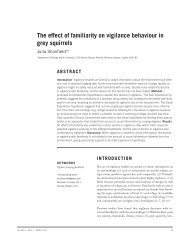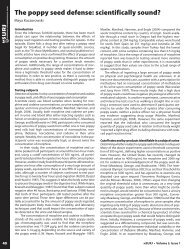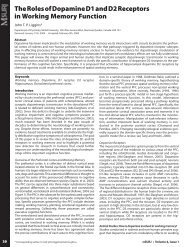the entire issue - McGill Science Undergraduate Research Journal ...
the entire issue - McGill Science Undergraduate Research Journal ...
the entire issue - McGill Science Undergraduate Research Journal ...
You also want an ePaper? Increase the reach of your titles
YUMPU automatically turns print PDFs into web optimized ePapers that Google loves.
A study of <strong>the</strong> effect of auditory prime type on emotional facial expression recognition<br />
Temporal window of 150 msec – 250 msec. The analysis for <strong>the</strong><br />
temporal window 150 msec – 250 msec revealed a significant main<br />
effect of prime type [F(1,35), p = 0.027]. Overall, we observed more<br />
negative ERP amplitudes for pseudoutterances than for vocalizations<br />
as well as for congruent trials than for incongruent trials.<br />
We also noted ano<strong>the</strong>r main effect of prime-target congruency<br />
[F(1,35) = 17.66, p < 0.001]. Fur<strong>the</strong>rmore, a grouping factor – region of<br />
interest (ROI) – was introduced into <strong>the</strong> statistical analysis. We saw a<br />
significant interaction of prime type, prime-target congruency, and<br />
ROI [F(6,35) = 2.60, p = 0.03]. This indicated <strong>the</strong> possibility that ERP<br />
amplitudes were modulated as a function of both variables in combination<br />
in certain regions. Fur<strong>the</strong>r analysis of specific ROIs revealed<br />
an interaction between prime type and prime-target congruency in<br />
left frontal electrodes [F(1,5) = 15.56, p = 0.01] and right frontal electrodes<br />
[F(1,5) = 7.17, p = 0.04]. In both regions, we observed significantly<br />
more negative ERP amplitudes in incongruent trials than in<br />
congruent trials for vocalizations. However, we observed significantly<br />
more negative ERP amplitudes in congruent trials than in incongruent<br />
trials for pseudoutterances. The effects in <strong>the</strong> left and right<br />
frontal regions are identical, so <strong>the</strong> FC2 electrode is used to illustrate<br />
<strong>the</strong>m in Fig. 2.<br />
Table 1 indicates <strong>the</strong> legend code to condition conversion for increased<br />
readability. A significant interaction between emotion and<br />
prime type was observed when ROI was used as a grouping factor<br />
[F(12,70) = 1.98, p = 0.039]. Fur<strong>the</strong>r investigation showed that <strong>the</strong>re<br />
was an interaction between emotion and prime type in left frontal<br />
electrodes [F(2,10) = 4.30, p = 0.045] and right frontal electrodes<br />
[F(2,10) = 5.50, p = 0.024]. In both regions, sadness was seen to elicit<br />
significantly more positive ERP amplitudes than anger and happiness<br />
for vocalizations, while it elicited significantly more negative ERP<br />
amplitudes than anger and happiness for pseudoutterances.<br />
Code<br />
Condition<br />
30 Congruent Angry Vocalization<br />
31 Incongruent Angry Vocalization<br />
40 Congruent Sad Vocalization<br />
41 Incongruent Sad Vocalization<br />
50 Congruent Happy Vocalization<br />
51 Incongruent Happy Vocalization<br />
60 Congruent Angry Pseudoutterance<br />
61 Incongruent Angry Pseudoutterance<br />
70 Congruent Sad Pseudoutterance<br />
71 Incongruent Sad Pseudoutterance<br />
80 Congruent Happy Pseudoutterance<br />
81 Incongruent Happy Pseudoutterance<br />
Table 1<br />
Code – Condition Conversion<br />
Discussions<br />
In <strong>the</strong> present study, we used analysis of ERP amplitudes to investigate<br />
<strong>the</strong> influence of auditory prime type on <strong>the</strong> judgment of emotional<br />
facial expressions. A previous study by Paulmann & Pell (9)<br />
investigated <strong>the</strong> effect of prime length and observed that medium<br />
length primes (400 msec or more) elicited a normal response in<br />
prime-target congruency in that incongruent trials elicited more<br />
negative ERP amplitudes than congruent trials. For this reason, this<br />
study made use of prime stimuli that were at least 400 msec in length.<br />
The main focus was to understand whe<strong>the</strong>r or not vocalizations and<br />
pseudoutterances convey emotional meaning to <strong>the</strong> same extent by<br />
comparing both <strong>the</strong> ERP amplitudes elicited by subsequent judgment<br />
of emotional facial expressions as well as behavioural results.<br />
Implications of Behavioural Results<br />
Behavioural results demonstrated that <strong>the</strong>re was a significant difference<br />
in <strong>the</strong> accuracy of emotional facial expression judgment between<br />
<strong>the</strong> vocalizations and pseudoutterances as primes. As reported,<br />
vocalizations allowed for more accurate judgment overall – an average<br />
accuracy of 88% – than pseudoutterances – an average accuracy<br />
of 84%. It is speculated that a reason for this difference is <strong>the</strong> very<br />
nature of <strong>the</strong> facial expression stimuli. Fig. 1 provides an example of<br />
<strong>the</strong> typical facial stimuli used in <strong>the</strong> experiment; upon inspection, it<br />
becomes apparent that <strong>the</strong> facial expressions resemble expressions<br />
one might have in a real-life conversation after having conveyed an<br />
emotion in a fashion that closely resembles a vocalization. It is possible<br />
that <strong>the</strong> relation between <strong>the</strong> vocalization as a prime and <strong>the</strong><br />
contextually similar facial expression allowed for more accurate responses<br />
by <strong>the</strong> participant.<br />
Unconventional N400 Congruency Results<br />
Studies have shown that prime-target incongruency results in more<br />
negative ERP amplitudes than congruent trials when primes of 400<br />
msec are used (5, 10). As previously mentioned<strong>the</strong> primes used in this<br />
study were at least 400 msec long, quite often reaching up to 2000<br />
msec in length. We used long primes in hopes that <strong>the</strong> conventional<br />
N400 pattern of congruency would be observed. This seemed to be a<br />
reasonable deduction based on <strong>the</strong> fact that emotional speech tone<br />
has been seen to influence <strong>the</strong> early judgment of facial expressions<br />
(1, 2). However, just <strong>the</strong> opposite was observed for pseudoutterances;<br />
congruent trials elicited more negative ERP amplitudes than incongruent<br />
trials. This was unanticipated, and <strong>the</strong> reasons behind <strong>the</strong><br />
phenomenon can only be speculated. It is well known that emotional<br />
information from an auditory prime is integrated early after hearing<br />
it (11). Perhaps excessive length of primes caused disintegration in<br />
<strong>the</strong> priming effect by <strong>the</strong> time <strong>the</strong> participant was required to make<br />
a judgment of <strong>the</strong> facial expression.<br />
Volume 8 - Issue 1 - March 2013 53









